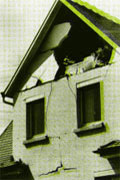On Broken Windows
The Broken Window is both a fallacy and a truth. In economics, it refers the Parable of the Broken Window, also called the Broken Window Fallacy, and it deals with hidden opportunity costs.
The basic idea is that it is temping to think that a hoodlum breaking a baker’s window stimulates the economy because the baker must go buy a window from the glazier, who then can go buy additional things from others in the community and so on.
However, the fallacy part of it is that forcing the baker to buy a window has the hidden cost of the baker not buying whatever it was that the baker might have wanted to buy in the first place — perhaps a suit. So the extra money to the glazier actually comes at the expense of the tailor, and on top of it, the baker is out a window. So when hidden opportunity costs are accounted, the net effect of a broken window is negative, not positive.
There is also the broken window theory of crime, which basically states that criminal activity tends to congregate towards lesser-maintained areas of a city, perhaps because the look of dereliction makes a criminal feel less likely to be caught. A recent article that I picked up of via Bruce Schneier’s Security Blog discusses a recent student on the broken window theory. The conclusions are interesting:
The results, just now circulating in law enforcement circles, are striking: A 20 percent plunge in calls to police from the parts of town that received extra attention. It is seen as strong scientific evidence that the long-debated “broken windows” theory really works—that disorderly conditions breed bad behavior, and that fixing them can help prevent crime.
[…]
Many police departments across the country already use elements of the broken windows theory, or focus on crime hot spots. The Lowell experiment offers guidance on what seems to work best. Cleaning up the physical environment was very effective; misdemeanor arrests less so, and boosting social services had no apparent impact.
Nevertheless, I still wonder whether the broken window theory is actually a type of fallacy. For example, it is true that a single person can stand up at a sporting event to get a better view, but this does not generalize well: if everyone stands up, it is decidedly not true that everyone gets a better view. Does the same apply to broken windows? In other words, does fixing broken windows in one area correspond to a single person standing up at the sporting event? If all broken windows were fixed, would crime actually diminish or would it sustain at current levels?
Regardless of the answer to that question, I think the last sentence — and especially the last clause — is worth repeating:
Cleaning up the physical environment was very effective; misdemeanor arrests less so, and boosting social services had no apparent impact.
Sorry social scientists.





